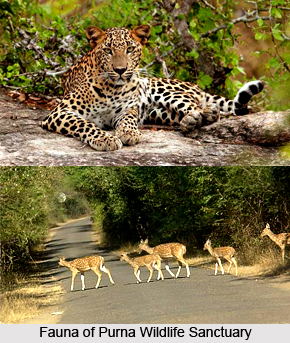 Purna Wildlife Sanctuary is a portion of the dense forests of Dang District of South Gujarat which is located in the western Indian state of Gujarat and is spread over an area measuring nearly 160.8 square kilometres. It has been declared a wildlife sanctuary during July, in the year 1990 and along with Vansda National Park as the only singular Protected Area in South Gujarat for safeguarding flora and fauna.
Purna Wildlife Sanctuary is a portion of the dense forests of Dang District of South Gujarat which is located in the western Indian state of Gujarat and is spread over an area measuring nearly 160.8 square kilometres. It has been declared a wildlife sanctuary during July, in the year 1990 and along with Vansda National Park as the only singular Protected Area in South Gujarat for safeguarding flora and fauna.
Purna Wildlife Sanctuary has been so named after the Purna River which flows across this part of the nation. Visitors would be welcomed by the green sights of the diverse vegetation and numerous species of wildlife which wander about the depths of this sanctuary. An ancient forest rest-house is present within the grounds of Purna Wildlife Sanctuary, which is often utilized for conducting nature camps. At the central portion of the sanctuary is Mahal village.
Climate of Purna Wildlife Santuary
The Sanctuary consists of thick forest covers of bamboo and teak. The climate is tropical there with moderate to heavy rains. 2500mm is the average rainfall received by the region. The place experiences three types of noted seasons that are summer, monsoon and winter. Winter starts from the mid November and stays till the end of February. The recorded average temperature during the month of January is 10 degree Celsius. Summer starts from March and stays till the end of May where the temperature ranges from 35 to 40 degree Celsius. Monsoon stars either from the middle of June or early July and stays till September.
Flora of Purna Wildlife Sanctuary
There exists various kinds of flora in Purna Wildlife Sanctuary which is filled with thick Bamboo outgrowths and as many as 700 species of plants including grasses, numerable species of Bamboo, other trees like Kalam, Sissio, Teak, Dudhalo, Khair, Haldu, Karanji, Safed Siras, Tanach, Chipadi Bondara, etc. Moist Teak Forests and Moist Mixed Deciduous Forests cover a major part of this sanctuary. The vast quantity of trees of this wildlife reserve creates a grand canopy within this region which presents a breathtaking view for visitors.
Fauna of Purna Wildlife Sanctuary
It is said that the wildlife of Purna Wildlife Sanctuary are worth witnessing and include animals like Sloth Bear, Wild Bull, Rhinoceros, Elephant and many others, which have been reigning in this area since historic times which can be dated back to the age of the Mughal Dynasty in India. However, apart from these animals, Leopard is the main predator of the sanctuary and their population keeps increasing with the passage of time. Numerable birds also have built their refuge in this area and if tourists are lucky enough they might even come across Rufous Woodpecker, Grey Jungle Fowl, Crimson Sunbird, etc.
Visiting information on Purna Wildlife Sanctuary
The most favourable time to visit the wildlife sanctuary is earlier in winter when the rivulets and rivers get filled with fresh water. Surat is the nearest city 100 kilometres away. It has an airport that gives the facilities of links with rest of the city. The nearest Railway station is Vyara about 20 kilometres away.











